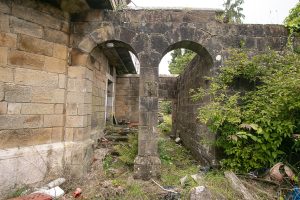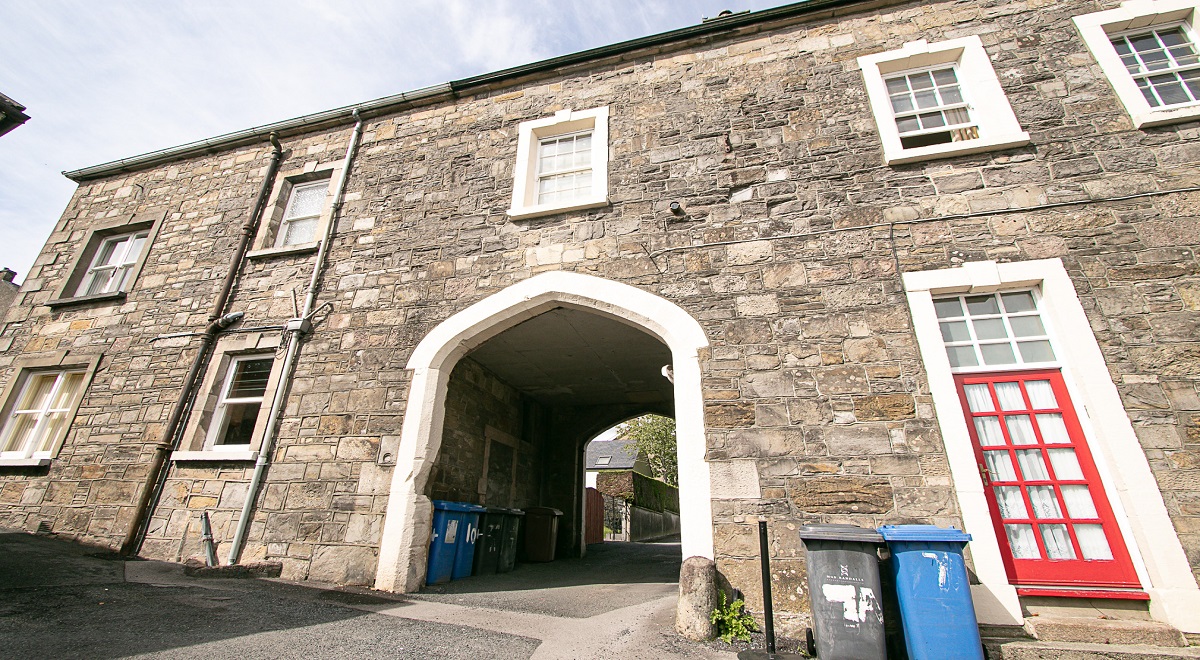Long before our current prison system of reform and prevention of crime, a brutalist approach was taken by the justice system, in which convicts were executed for their crimes.
Omagh was no different during this time, and many wrong-doers were sentenced to the noose, initially at Gallows Hill (hence the name!), and then at Omagh Gaol.
During the growth of Tyrone, Omagh was declared as the ‘county town’ in 1768.
With this new-found title, the need for a county prison became apparent, and the first gaol was erected on High Street (where the courthouse stands now).
This gaol was built in the traditional model, which incorporated both the prison and the courthouse, for the convenience that those arrested could be tried and sentenced before a magistrate in a short period of time within the same building.

However, due to changing practices in criminology, it was decided that the gaol and courthouse should be separated, and the new gaol was moved to Castle Place in 1790, and officially opened in 1804.
This new gaol was designed by a man named Edward Millar, who, at this stage, was well-equipped for designing these punishment institutes. He had also designed the county gaols of Derry and Donegal.
Of Millar’s design, what currently remains are sections of the stone walls that surrounded the perimeter of the gaol.
Back in the early 1800s, the prison board saw no need to segregate the inmates, so all men, women and children were gathered into the one cell, with the only exception being the criminally-insane, who were isolated in their own section of the gaol
The cells, which held up to 14 inmates, were cramped and squalor, with comfort left out of the creation specifications.

However, after 20 years of running the gaol in these conditions, some relief came to the inmates through legislation.
Moving away from the brutalist style of the traditional gaols, the 1823 prisons (Ireland) Act compelled prison management to adopt a ‘broadly reformist regime’ to shift prison practices.
The new focus was to instil practices of reform, prevention and rehabilitation to criminals.
In addition to the shift in punishment delivery, this new act urged for expansion of prison operations to give the inmates some liberties.
For the Omagh Gaol, this meant the appointment of a three-man commission to oversee the expansion of the gaol.
The Grand Jury for County Tyrone elected Jones Crawford, John Dixon Eccles and Captain John Corry Moutray to oversee this enlargement of the prison.
Plans were then put in place to erect a governors house, a new polygonal cell block and the gaol’s own infirmary.
In addition, the gaol would also be furbished with a building which would incorporate a laundry and chapel in one, to save on space.
This expansion brought some liberties to the inmates, as work was now dispersed; giving them a purpose to serving their mandatory sentence.
Many served in the laundry, others in the kitchen and men were given the task of rock breaking.
An inmate’s living conditions improved drastically, too, as the women were now separated into their own cell blocks, and the crammed 14-people-cells were now reduced to three-per-cell.
Again, with many of Omagh’s architectural structures at the time, the well-sought John Hargraves, who also designed the courthouse, was given the contract to draw out the new additions to the gaol.

Hargraves used the same sandstone which was used to construct the courthouse to build the gaol’s new sections.
Some of these buildings still stand today, though barely recognisable, with the exception of the warden’s gate and Governers House, which have both kept their original exterior design.
The infirmary and church both remain on the site, though have been been re-purposed as housing and storage.
In the gaol’s short 100 year history, it had seen a fair share of famous – or infamous – individuals enter its gates.
In this time period, the sentences of justice were not as complex as they are now.
Prisoners were not routinely sentenced to lengthy periods of imprisonment.
They were, rather, whipped, held for a short period of time under severe conditions, or detained until such a time as they could be transported or executed.
However, one infamous prisoner in the gaol was the disgraced Royal Irish Constabulary inspector, Thomas Montgomery, who was convicted of killing a Newtownstewart bank clerk.
Montgomery had been facing financial difficulty after building up gambling debts, and killed the clerk to take a sum of money.
The inspector had, initially, investigated the crime himself, however his subordinates got suspicious of Montgomery, and an eyewitness came forward saying they had seen Montgomery leave the bank an hour before the body was found.
Montgomery was sentenced to death by hanging, but this presented a problem that many gaols had at the time: There were little-to- no executioners in Ireland.
For this reason, the Home Office brought Lincolnshire shoe-maker turned ‘hangmanship’ expert (proclaimed by himself) Mr Marwood to undertake the hanging.
Though popular at the time, hangings were seldom, and gaols preferred shorter sentences or prisoners to be sent to the newly- founded prison colony of Australia.
Another infamous prisoner held in the cells during the mid-1800s was John Moyle O’Mahoney; founder of the Fenian Brotherhood in the United States, a sister organisation to the Irish Republican Brotherhood.
O’Mahoney was subject to sentencing by transportation to a prison far away from his place of arrest, which happened to land him in Omagh Gaol.
However, upon O’Mahoney’s arrival into Omagh via the railway, a crowd of 200-300 attacked the soldiers and police officers during the transportation to the gaol.
Throughout the years, as larger prisons are erected, Omagh’s inmate population fell.
In 1901, the Omagh Gaol was ordered to close due to the lack of prisoners being held in the cells.
The sole occupant by this time was a caretaker, and the gaol buildings lay vacant, neglected, and prone to vandalism.
The grounds were sold to Mountjoy man, William Forsythe Porter for £660 in 1909, who tore down several of the buildings, including the cellblock, and sold their stone to construction contractors.
Today, the history of the Gaol Square lays hidden under the façade of modern housing, with a trail of architectural clues being the only remainder of the site’s grim past of punishment and death.
Did you know?
- The gaol’s church was separated by a partition wall so the men and women prisoners wouldn’t see each other.
- In 1823, famous prison reformist Elizabeth Fry visited and stayed a night in the Omagh Gaol, residing in one of the three bedroom’s of the Governer’s house. Elizabeth was well known for her advocacy to reform the conditions women faced in prisons at the time.
- A prisoner’s weekly diet in Omagh Gaol was 25 kilograms of potatoes, seven pints of milk and three and a half kilograms of oatmeal.
- The Gaol admitted mentally ill patients to a separate section due to the absence of a mental institution until the Tyrone and Fermanagh hospital (T&F) opened in 1859.
- The Governor’s house had a single storey annex which was used as a kitchen and staffed by fellow prisoners, under the watchful eyes of the guards of course.
- It was a requirement under the terms of the Prisons Ireland Act of 1826 that no prisoner was permitted to enter the Gaol proper before being examined and certified free from infectious diseases.
- For this reason, new prisoners were given a cold medicinal bath and examined for diseases before being admitted.
- The infirmary was only used in emergencies and as a last resort, as the medical officers preferred to treat prisoners in their own cells.
- If you look at the building next to the Governor’s house, you can see the church style architecture left over from its original purpose.
- The warden’s gate which can be seen when coming through Castle Place used to have two heavy iron gates. These gates were used as a measure to prevent prisoners from escaping and checking movements as they came in and went out. Both gates were not allowed to be opened at the same time.
- It is believed that as punishment, the prisoners were given a full day of pulling the thread mill, which was used to supply the Gaol’s drinking water.
- When the gaol was first moved from the Courthouse, an Inspector’s Report in 1822 said the only good thing about the Gaol was its location ; otherwise it was badly constructed and the prisoners were not classified or employed. Debtors were placed alongside criminals and there were 14 in a cell, in which they did their own cooking.
- The last man handed in Omagh Gaol was Peter Conway from Carrickmore. After the jail was closed, his grave marker, inscribed PC 1889, was used to build the wall around Old Culmore School. It was erected upside down.
- Stones from the gaol were also used to erect a second storey on the former Christian Brothers Primary School and the Grotto at the Sacred Heart Church.







